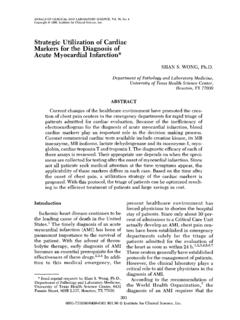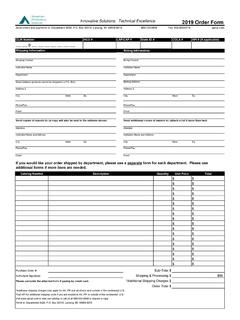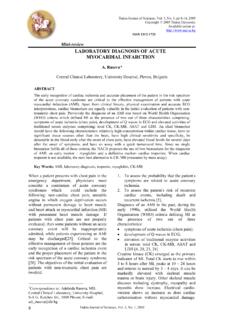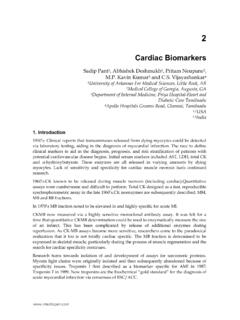Transcription of Learning Objectives Cardiac Biomarkers - Columbia University
1 1 Cardiac BiomarkersMichael A. Pesce, Professor of PathologyColumbia UniversityDirector of the Specialty LaboratoryNew York Presbyterian HospitalColumbia University Medical CenterLearning ObjectivesBy the end of this session you will be able to: Discuss the biochemical markers that are used to detect myocardial infarction Discuss the sensitivity and specificity of CK-MB and the Troponins for the detection of myocardial infarction Describe the pitfalls associated with the immunochemical methods that are used to measure Troponin IAnnual ED Visits in the United States6 Million - Chest Pain100 Million ED Visits3 Million Discharged3 Million High RiskMissed AMI30.
2 0001 Million Other Diagnosis1 Million AMI1 Million Unstable AnginaProgressionAcute Coronary SyndromeRiskClinical DiagnosisPathophysiologyMyocardialInfarc tionAsymptomaticAnginaACSP laque Distribution C-Reactive Protein, Lipids, PAPP-A, Amyloid AMyocardial Necrosis Troponin, CKMB, Myoglobin Myocardial IschemiaIMA, FFA, IL-6 Intracoronary ThrombusThrombus Precursor Protein D-Dimer, P-SelectinDiagnosis of AMI WHO Criteria Must meet 2 out of 3 criteria Clinical presentation, chest pain >20 minutes ECG changes Positive serial Cardiac enzymesDiagnostic ChallengesAMI patients may present to the ED with non-diagnostic ECG ~ 50% of the timeChest pain may be a dull pain.
3 Burning sensation or a sharp stabbing pain~35% of patients do not have chest pain50% have no history of MI or angina2 Cardiac Biomarkers CK-MB Myoglobin Troponin I and T BNP NT ProBNP Ischemia Modified AlbuminIdeal Cardiac marker for Myocardial Injury Found in high concentrations in myocardium Organ Specific detected only in heart muscle Released rapidly and completely after the onset of pain Concentration is proportional to the extent of damage Remains elevated for several days Easy to measure Rapid turnaround time Cost effectiveCKMB BiochemistryCK: Dimer composed of 2 monomers: M (43,000 Da) andB (44,500 Da)---- > CK BB or CK MB orCK MMRole:Creatine + ATP <---> ADP + Phosphocreatine + Energy(muscular contraction)CK BB = CK1 Increased in neurological diseases; prostatectomy.
4 Digestive cancersCK MB = CK2 Increased with AMICK MM = CK3 Increased in myopathy, hypothyroidy, polymyositis,rhabdomyolysis, traumatism, intensive exercise, AMI Tissue Distribution Of CK & CK IsoenzymesRange of Total CK Range of CK IsoenzymesU/gm(%)Tissue tissueMMMB BBSkeletal Muscle 1080-3050 96-100 0-4 0 Heart Muscle 190-692 58-86 15-42 0-1 Brain73-200 0 0 100 Bladder 162 0-2 0-6 92-100 Placenta 250 19 1 80 Colon 200 0-5 0-4 95-100 Ileum 175 0-4 93-100 Stomach
5 170 0-5 4 96 Diaphragm 140 96 422 CKMB KineticsAFTER AMII ncrease 4-6 HoursPeak 10-24 HoursReturn to Normal 48-72 Hours Draw blood on admission,4, 8, 16 and After Onset of Chest Pains, HoursKinetics of CKMB Release After AMIB aseline LevelCKMBLEVELx Normal02-fold4-fold6-fold8 foldReinfarction48121620243 CKMB IN AMIA dvantages: Detects AMI 4-6 Hours After Chest Pain Methodology is Rapid and Automated Turnaround Time <20 Minutes CKMB was the gold standard for AMI detection in the 1980 sLimitations of CKMB in AMIE levated CKMB Levels can be observed in.
6 Skeletal Muscle Involvement Duchenne Muscular Dystrophy Polymyositis Alcohol Myopathy Thermal or Electrical Burn Patients Carcinomas Colon, Lung, Prostate, EndometrialMyoglobinBiochemistry Myoglobin is a relatively small ( kDa) globular protein It is a heme containing protein It constitutes about 2 percent of muscle protein in both skeletal and Cardiac muscle The prime function of myoglobin is to store oxygen in muscle for release during oxygen deprivationMyoglobin MoleculeMyoglobinPresent in Cardiac and Skeletal MusclePost AMI Myoglobin CKMBI ncrease Hrs 2-4 4-6 Peak Hrs 5-9 10-24 Return to Hrs 24-36 36-76 Normal Myoglobin in AMIA dvantages.
7 Early Indicator of AMI Methodology Automated Results Available in <60 Minutes Concentration is dependent upon the amount of Cardiac damageLimitations of Serum Myoglobin in AMII ncreased In: Exhaustive exercise Skeletal muscle damage Progressive Muscular Dystrophy Shock Renal Failure Following IM injection4 Time course of Myoglobin and CK-MB after an AMI0200400600800081624324048 Time after symptomsMyoglobin (ug/L)0102030405060CK-MB (ug/L)MyoglobinCK-MBSpecificity of CK-MB Mass & Myoglobin In Noninfarct Patients with Chronic Renal Failure or Severe PolytraumaPathology No.
8 (%) of Specificity& MarkersPositive Sera%Severe Polytrauma (24 Sera)CK-MB mass14(58)42 Myoglobin21(88)12 Chronic Renal Failure (49 Sera)CK-MB mass4 (8)92 Myoglobin43(88)12 SummaryMyoglobinMyoglobin Excellent early marker for myocardial damage Skeletal muscle damage can also greatly increase serum levels CKCK--MBMB CK-MB exists as three molecular forms MM, MB, BB After myocardial infarction, elevated CK-MB levels appear within 4 to 8 hours, peaking within 9 to 30 hours, and levels return to normal after 48 to 72 hours The time to appearance of elevated levels is slower than that for myoglobin Although CK-MB is present at low levels in skeletal muscle.
9 Skeletal muscle damage can potentially lead to false-positive diagnosis of AMIT roponin Characteristics Troponin C (18 kd) Calcium-binding subunit Troponin I ( kd) Actomyosin-ATP-inhibiting subunit Troponin T (39 kd) Tropomyosin-binding subunittroponin complextroponin complexTnCTnITnTTnCTnITnTtropomyosintrop omyosinactinactinCa2+Ca2+The troponin complex consists of three different proteins (TnC, TnI, and TnT) that regulate the calcium-mediated contractile process of striated Specificity of Troponin Subunits Troponin C is the same in all muscle tissue Troponin I and Troponin T are detected in heart muscle and are Cardiac specific Circulating concentrations of cTnI and cTnT are very low cTnI and cTnT remain elevated for several days The false-positive CKMB results that are due to skeletal muscle involvement should be eliminated with use of the Troponin I and TCardiac Specific MarkerPost AMI Troponin I Troponin T CKMBI ncreaseHrs
10 4-6 3-64-6 PeakHrs14-24 10-24 10-24 ReturnDays5-7 6-102-3to Normal5 Troponin I, CKMB & Myoglobin192 Patients With Chest Pain Clin Chem 45,59 Had An AMI 199-205, 1999 Troponin I CKMB MyoglobinSensitivity %<6 hr 65 78 756-24 hrs 72-93 78-80 73-75 Specificity %<6 hr 100 91 746-24 hrs 94-97 82-86 68-82 Specificity of cTnl, CK-MB Mass & Myoglobin In Noninfarct Patients with Chronic Renal Failure or Severe PolytraumaPathology No.



















